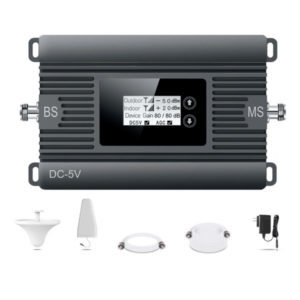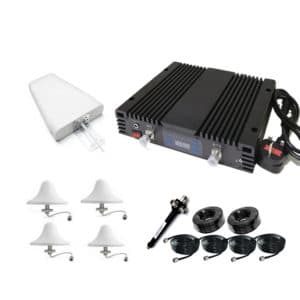¿Cómo garantizar la seguridad en una empresa a través de las comunicaciones?
Find out how you can strengthen communications in your company and ensure business security by eliminating cell phone dead zones.
Communications in your company are key to guaranteeing security
The most important factor related to workplace safety is not equipment failure or lack of employee training, it is communication. A study by the United States Federal Aviation Administration reports that only 30% of verbal communication is understood by both parties in the conversation, and most people only remember the first and last things that are said to them.
Lack of communication is a very human failing and one that is only made worse when it comes to unreliable wireless communications in the workplace. Construction, logging, mining, and other industries are often challenged by weak cellular signals. Which makes not only person-to-person communication difficult, but also machine-to-machine interactions. Construction sites face the challenges of cellular dead zones in buildings. Logging, gas and oil sites are often in remote locations where the lack of proximity to cell phone towers provides weak signals. The mines sink deep into the ground, which acts as a natural buffer for mobile phone signals.
The traditional solution: two-way radios
Two-way radios in a company provide solutions for communications. This has been known long before the popularity of mobile phones began, but radios have several disadvantages.
Two-way radios in a company can communicate with multiple workers at once, as long as they are all on the same frequency. So they can be used to send emergency alerts. Most workplace radios are half-duplex, meaning that one person must press and hold the radio button to speak and then release the button to hear the other person’s response. By necessity, this slows down communication, which can pose a threat in emergency situations where immediate responses are required.
The role of two-way radios
Two-way radios are relatively bulky and are generally worn on the worker’s belt. In noisy environments, this can cause the employee to miss important communications. When it comes to reliability, several factors negatively affect radio transmissions, including weather, transmitter power, and distance. Buildings and other obstructions can interfere with transmission, since radio signals rely on “line-of-sight propagation” to send and receive signals.
Workplace radios may use VHF or UHF radio frequencies. The lower frequency signals fall into the VHF (Very High Frequency) or lower bands. Therefore, VHF or Very High Frequency is generally the best option for outdoor use. For job site communications on construction sites, the shorter wavelengths of UHF or Ultra High Frequency are a better choice. As they are more likely to move unhindered through small openings in buildings. Radio waves with frequencies above the UHF band fall into the super high frequency (SHF) or microwave range.
Wireless headsets and communication in companies
Wireless cellular headsets are an alternative to traditional workplace radios. Headsets are typically full-duplex, allowing communication in both directions without the need to press any buttons. Up to sixty workers can communicate via headsets on a configurable wireless system. Also, using wireless headsets is more like attending a conference call than using radios.
The workplace advantage cannot be underestimated here. Emergency alerts, information and instructions can be sent to all workers at once. Employees can quickly check in, pinpointing their location and current status with less delay.
Wireless headsets address an important aspect of business security in noisy environments. Noise-dampening headphones protect employees from hearing-damaging noise without affecting their ability to hear messages that might be missed when using radios.
Machine-to-machine communication in the workplace
In addition to human communication, the modern enterprise must consider the interactivity of smart devices. Machines and equipment are increasingly part of the Internet of Things. Smartphones, computers, security systems, security equipment, and other machinery must be able to transmit data over a reliable network.
With a reliable network, equipment can be remotely controlled via phone apps and monitored for power consumption and performance issues. With equipment designed to provide early warning of danger, such as gas detectors in the oil and gas industry, an online connection allows automatic alerts to be sent to employees. Our mobile signal boosters ensure constant connectivity for robust data communication.
Challenges for wireless communication in a company
Implementing wireless workplace communication brings its own challenges. The signal of a Wi-Fi network is spread out in an invisible globe, with the wireless router in the center of the sphere. Any device outside the sphere cannot receive a signal.
Dentro del rango de Wi-Fi, la señal viaja a través del espacio aéreo libre. Las paredes gruesas, como las que se encuentran en los hospitales, pueden amortiguar la señal, creando zonas muertas donde la comunicación no es posible. Los pozos de las minas son conocidos por sus zonas muertas celulares. En tales casos, los amplificadores de señal y las antenas colocadas estratégicamente pueden fortalecer las señales de Wi-Fi.
La comunicación inalámbrica generalmente funciona asumiendo que los empleados usarán sus propios teléfonos. Traer tu propio dispositivo (BYOD) conlleva la posibilidad de vulnerabilidades de seguridad, ya que la configuración de cada teléfono varía ampliamente. Proporcionar a los empleados pautas para proteger sus teléfonos del malware ayudará a reducir este riesgo. Los empleados también deben comprender la necesidad de comenzar los turnos con teléfonos completamente cargados. Una batería muerta corta efectivamente al empleado de todas las comunicaciones en el lugar de trabajo.
Las redes Wi-Fi se consideran menos seguras que las redes de comunicación por cable. Mantener actualizado el firmware de su enrutador reduce en gran medida el riesgo de violaciones de seguridad.
Signal amplifiers to guarantee security in a company through wireless communications
Signal boosters increase the range and strength of your wireless signal. This allows the signal to penetrate dead zones and ensures a reliable network for workplace communications. The following four cellular signal boosters are certified and suitable for large-scale businesses.






